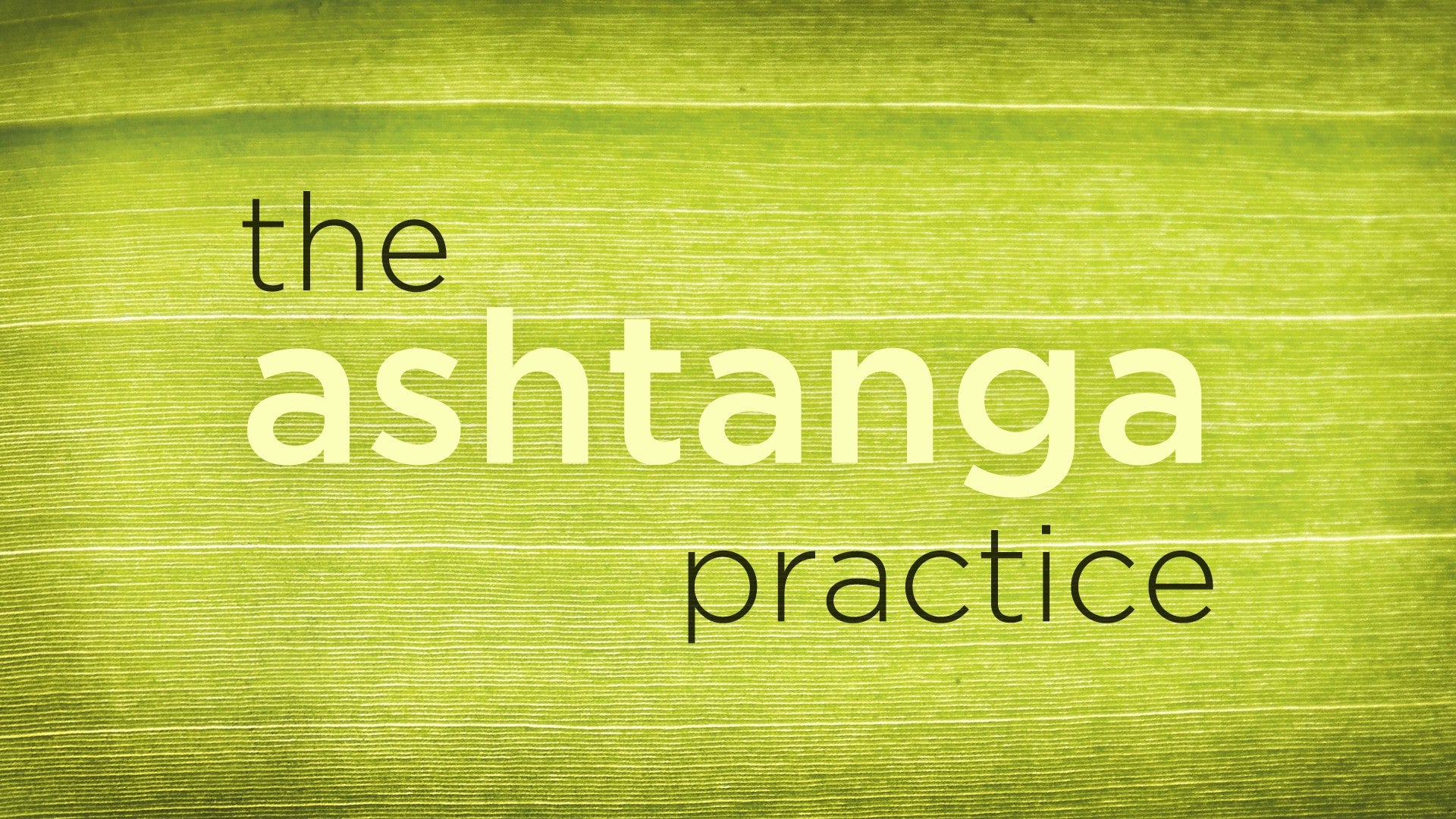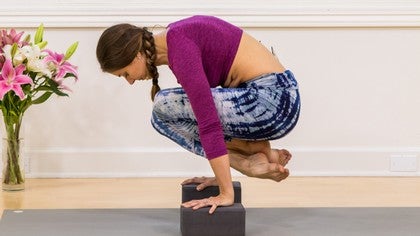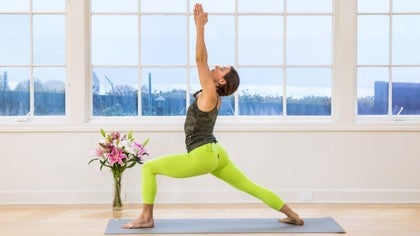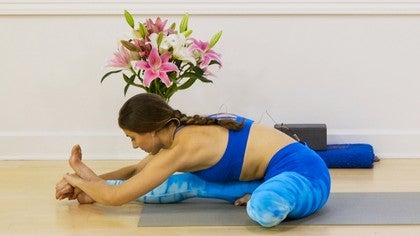Description
About This Video
Transcript
Read Full Transcript
[Waves breaking] Welcome. So today we're gonna talk a little bit about transitions and then we'll go into a small practice, more of a tutorial style just to find ways that we can start to work on some of the transitions that we have in Ashtanga, mainly the picking up and jumping back and the jumping through to seated. In Ashtanga, the breath, the bandhas, and the drishti are all the most important components of the practice. And if we start to wonder why, why are these so important, it's a question I've had throughout my practice, and what I'm coming to understand now is the reason that they're so important, the practice is led by, it's a vinyasa-style practice so what does vinyasa mean? Well, one meaning is to place in a special way. So each count has a different movement associated with it, and we're usually placing things from one position and then the next is a transition until we place it into another position.
So that time in between is all a part of the practice as well. So it's not only like in some styles where we're in the poses and we're very present and very active in the postures but then in between postures we just do whatever. Is ashtanga actually the time that you step on the mat until the time you step off the mat is all a part of the practice, and hopefully even after you've stepped off your mat you're still practicing. However, the focus that we get when we're concentrating on the breath, the bhandas and the drishti, we're basically practicing directing the mind or having the mind direct the body. So we're first emphasizing breathing and moving at the same time.
For a lot of us, just controlling the breath can be a lot of effort. It's hard to gain control of the breath. Then we're trying to coordinate two things, the breath and the movement. Then we're asked to now start to direct the drishti, the gaze, so we're breathing, moving, and we're told to look in certain places. And then one other subtle aspect is we start to focus on our bhandas, the root lock.
So if we can start to direct and control the mind and our practice and have the mind with intention tell the body what to do, that's where it starts in the physical practice but then we ideally carry that on into our life. So we're controlling our subconscious, our intellect, and who's controlling it, we're connecting with source, so we're being guided, we're being guided by something else. Many of us are driven by our impulses and when you start the practice of yoga you get on a mat and we're told what to do by our teacher, or we're given some guidance of what to do and then at a certain point, it just starts to happen. We're trained and we just happen to something else. So the breath, the bhandas, the drishtis, the transitions, they start to make sense the longer that we practice them.
And I've seen many people get frustrated with that pick up and jump back and I myself was frustrated, it took me about four years to get that transition but when it started to click and started to make sense was when I really just did that practice, I took the tristana, the breath, the bhandas, the drishti, the asana, when I took those and I integrated them all. And it was like something I never wanted to let go of in the practice, if I really held the bandhas the whole time, and the whole practice was about lifting and toning the pelvic floor as I'm coordinating the breath and the movement and the drishti, then at a certain point, they all started to link together. So more important than actually being able to do the pick up and jump back, more important than that happening is actually the focus and the intention on keeping those three points. So we're gonna start off with sun salutations A and B and I'm just gonna talk through them and give you some ideas of where I was able to find that a little bit more. And it comes mainly from whenever we're transitioning the weight from the feet to the hands or the hands to the feet.
And with intent, starting to change your rooting so in samasthiti, for instance, our feet are on the floor and that's where we're rooting. And as we place the hands to the floor, the next step is to jump back to chaturanga so we have to transfer the weight from the feet to the hands and then the feet get light, they step back, now we're on all fours, up dog, down dog. Then from down dog we have to transfer the weight from all fours onto our hands and then back onto our feet. So paying attention to what's rooting you to the floor and looking at that almost as an extension of the bandha. So I'll come up to standing, for Surya Namaskar A and we'll come to the front of our mat, feet together, hands to prayer position at the heart.
So right here in samasthiti, I'm focusing on pressing down into the feet and relaxing into the feet. And then from the lower belly, pulling in and up, and even lower than the lower belly, the pelvic floor. Just finding a subtle lift through there and that's not tensing up, clenching at all. For me, it's not even squeezing the anus as I hear sometimes, it's much more subtle of a lift. Slight lift in the pelvic floor.
And then as we reach the arms up, we're holding that lift and the gaze comes up to the thumbs, with exhalation continuing to hold that lift in the pelvic floor as you fold forward so sometimes the mistake that happens here is we over-widen the sitting bones and splay the backs of the legs. Keep a little containment there, pull the lower belly in as you're folding and I actually start to think about the sitting bones pulling together as I'm folding down. And then hollowing out the belly as I'm folding forward. Then inhale, looking up and lengthening. Now for me, at my level of flexibility, I can keep the hands flat here, so I'm equally pressing into my hands and my feet.
Some of you may need to bend the knees in order to find that. Or, another opportunity is to start, rather than coming to the fingertips or the hands to shins, you can start bringing the hands forward and bending the knees. So you can start leaning into your hands and getting lighter in the feet. And then, it can even be a step, so sometimes the jump is actually too jarring and it's hard to maintain that connection and it gets really sloppy and I always think of it like, once you let the bandha go, it's harder to find it, so just don't let it go. So maybe it's about bending the knees, setting the hands down and just leaning, keeping it contained as you bend the elbows and step back.
So that's another thing, is that if you're gonna start working on it, you can bring the hands forward, already bend the elbows, and as you're stepping back, bend the elbows more. Then inhaling to upward-facing dog, exhaling to downward-facing dog. Then in downward-facing dog, continuing to find that root lock. So sometimes we're told to lift the sitting bones up to the ceiling and there may be a time in your practice where that's important, especially if you have more of a tucked-under pelvis and tighter hamstrings, you may need to work a little bit of that action and I'm not saying that's a wrong cue or incorrect for you, but at a certain point, you can start to pull the sitting bones in, pull the lower belly in, and find the bandha. And now we're in downward-facing dog and the next step is to step or jump the feet to the hands so I, for awhile I practiced this just by bringing the shoulders forward, walking with toes, like tiptoeing forward.
Now notice my shoulders actually come forward of my wrist. One place where we get jammed up is that we don't bring them far enough forward. Think of it almost like a handstand, shoulders coming forward, rounding, pulling up, can even try to toe-tap there, and then landing softly. So it's just starting to take the weight from the feet into the hands. Leaning forward.
And then if you're gonna jump, or try the jump forward, first it can be nice to start jumping from a shorter down dog. And just playing around, this is helpful even in poses like Bakasana B, jumping from a short down-dog instead of a long one and just making it about a transition, little hop. And then the same with jumping forward. Sometimes you'll have people do this, this is something I learned from one of my teachers. Used to walk across the room like that.
So it's really more about transferring the weight from feet to hands, or all four to just the hands. And then inhaling, exhale and fold. And inhaling, coming all the way up, and exhaling. And we have Surya Namaskar B, we bend the knees, sit the hip backs, and inhale the arms up, exhale, fold. Inhale, look up and lengthen, same thing here, can bend the knees and just make it like a step back as you bend the elbows.
Inhale, up-dog, exhale, down-dog. Now the step forward for Virabhadrasana 1 is really important, so a lot of times it's just like a step here, then we have to lift the leg the rest of the way, and that's okay, that's how we progress. If you start to round the back and really maximize this, so look at the difference between plank pose and when we're stepping forward. You can make space between the shoulders to step the foot forward inside the hand. So I'm actually pushing the floor away from me and rounding.
Now look at that and then oppose like Lolasana. Hands down, we have to really round the upper back. So it's the same kind of effort of in between the shoulder blades, lifting up. So as you're stepping the foot forward, rather than what happens a lot of times, is we lift this right hand to step forward, see if you can challenge yourself by keeping the hands flat, rounding, step forward, pivot the heel down, and come up into Vira 1. And then the same thing on the other side, of course.
Rounding. And then to take that a little further, you can start planting the heel down, rounding, and same with the other side, plant the heel down first, round, step the foot forward. Come up, and then same with the way back. All just little places where we can find a little more opportunity to round and practice Lolasana, which we'll be doing now. So you can do this with blocks.
So using blocks is like raising the floor up, it gives you a little more space so that you can get a sense of lifting the knees up off the floor, the shins, and the feet. It feels impossible in the beginning, the first time I tried it, I was like, "There's no way my feet are coming up off the floor" but then they start to at some point, the more effort and the more often we practice it. So it can be done with your shins together or ankles crossed, we're gonna do it all three ways. Take the hands on the blocks, lean forward, so notice the elbows are bent, belly pulls in, find your bandhas, at least visualize it or get a sense of it, and then you'll press the arms straight, lift the knees up, and the first one we're just gonna do with the feet on the floor but the knees lifting up, so you'll push the hands, lift the knees up and lean forward. And then lower down and we'll do it again.
This time, what I often see is that when we try to lift the feet up, we turn it into a hop but it's not a hop, it's really just a lift. So bending the elbows, inhaling up, and holding and then lowering down. And then we can do it with crossed ankles and in some ways the crossed ankle is a little more helpful, so there's a little bit of work in the backs of the legs, the hamstrings in order to hold the heels up closer towards your sitting bones. With the crossed ankles, now my left ankle is over top of my right, so I can keep the right foot on the floor, and when I lift up I can hopefully get the left one up off the floor. So bend the elbows, exhale strongly, lift up.
And then release, change the cross. Left foot will stay on the floor this time. Bend the elbows, exhale, lift up, and release. And we'll just try it with both feet up off the floor, see what happens. Bend the elbows, exhale.
And then release, and then the other way again. Deep breath in, exhale, bend the elbows, lift up. Maybe in the beginning, working with the blocks, trying to find it there, and then possibly doing it without the blocks. The Lolasana is really a great place to work on that transition. So if you're practicing for a series regularly and it comes time to take the vinyasas...
there are so many of them, it gets really tiring so you can, what happens is as we get tired, sometimes we get sloppier and sloppier, and it's almost not even worth doing them at a certain point 'cause you're practicing more being sloppy and flopping around on a mat. Doesn't mean don't do them, but if you can slow them down, and find places to take off some of the stress of the pose and make it harder in some ways and easier in other ways. So how I'll have people do this is drawing the knees into the chest, setting the hands down, and keeping the toes on the floor, lifting up, sometimes you have to move the hands, if you can here, you try to lift the hips up and tiptoe, at this point we start bending the elbows as we step back. Up-dog, down-dog, and then the same for coming through, you bring the shoulders forward, start to bring the knees into the chest, walk the feet forward, and then straighten the legs and lower down. So at that point, it's more about keeping the vandas lifted, and you take the jumping out of it so you're really focused on that.
So there's a few places to build strength, one is right here in the beginning, keeping the heels in, and the knees into your chest, so you're tucked into a tight little ball, even that will get your hip flexers working, core working, bandhas working, then we take the hands down in front of the hips. Now we have to transition from here to Lolasana, so it's here, then this is the place where, well people get stuck there too, but this is the place that's even harder, 'cause now you have to find Lolasana and bend the elbows as you shoot the legs back to chaturanga. That's where it gets tricky, that's why when you're here, if you start bending the elbows as you step back, you're walking on the arm strength part of it. So from Lolasana, and inhale up, and exhale back. And the jump through can be done with straight legs but sometimes it's actually beneficial to practice it with the bent knees because it's a little bit more, a lot more like the jump back.
So you can jump, of course we have the stepping version. You can also practice just jumping and landing lightly. So looking forward, and then straightening the legs. To at least get you used to lifting in the last moment before you straighten the legs. So we'll come back to down-dog.
Look where you're going, press your hands, exhale completely, and look my foot got stuck on my arm. Okay, and then the straight leg version. And I remember some people who didn't even seem like they had that much strength, but they somehow mastered momentum and they could just fling their legs through, so we're all different, we're all unique and that's what makes it fun. And if this part of the practice is a struggle for you, don't worry, it was for me, it is for, I know some people who are practicing third, fourth series and they still can't do the jump back or jump through and, you know, it doesn't mean anything, really. So continue to try, most importantly, honor your practice, the breath, the bandhas, the drishtis, and have fun.
Thank you.
The Ashtanga Practice: Maria Villella
Comments
You need to be a subscriber to post a comment.
Please Log In or Create an Account to start your free trial.











